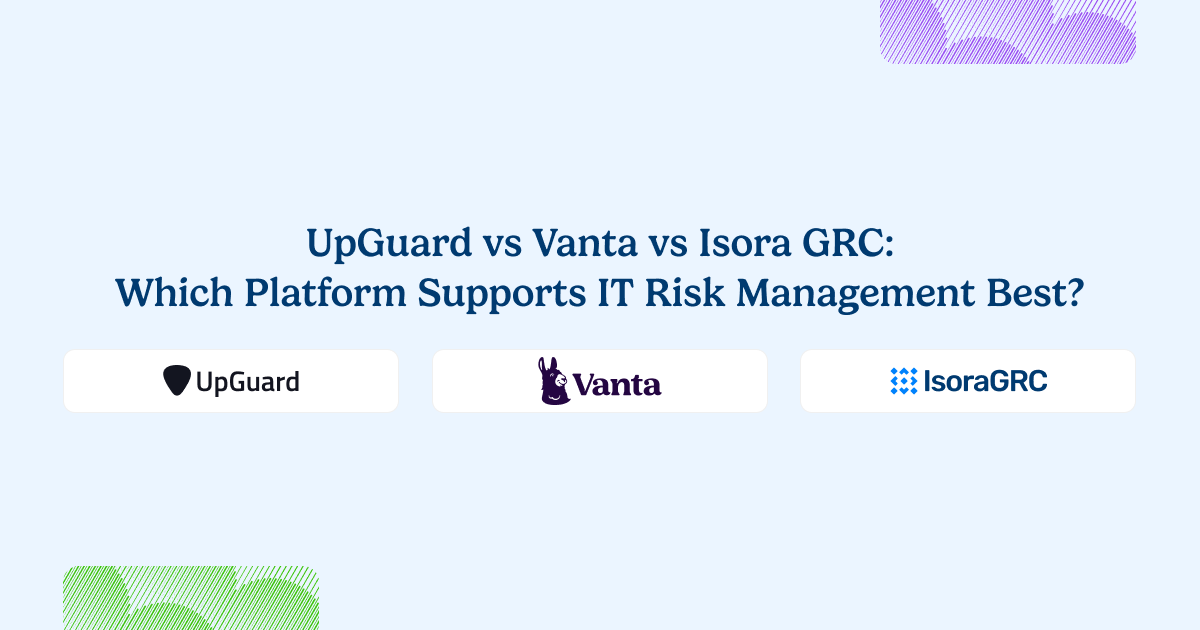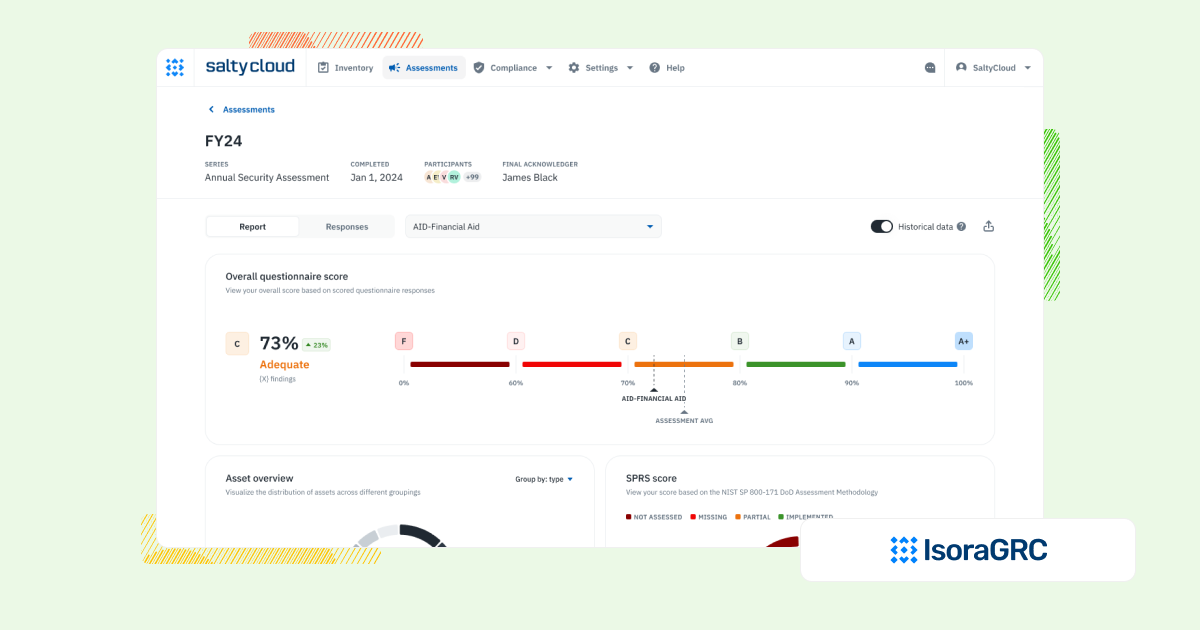
Every security team needs a complete, scalable way to manage IT risk—not just chase audits or external scores.
Platforms like UpGuard and Vanta focus on different parts of the GRC landscape: vendor risk intelligence and compliance automation.
External scores can highlight issues, but they don’t help you assess, track, or resolve them. And while compliance automation tools simplify audit prep, they don’t support the deeper workflows needed for real risk management.
Isora GRC takes a different approach. It’s purpose-built for security teams who need to assess vendors, manage inventories, and track risks—without depending on third-party scores or audit checklists alone.
Let’s inspect this more closely.
Choosing the Right Platform for IT Risk Management
UpGuard focuses on external vendor scoring. Vanta automates evidence collection for audits. While both tools offer value in narrow use cases, neither is built to support full-scale IT and third-party risk workflows. UpGuard gives visibility into external signals, but it doesn’t help teams run risk assessments, manage remediation, or maintain a risk register. Vanta accelerates SOC 2 readiness but lacks the tools for tracking risk across departments, vendors, or exception processes.
Isora GRC brings these capabilities together in a unified platform. It lets teams issue internal and third-party assessments, collect structured evidence, manage exceptions, and maintain real-time risk visibility. Designed for security teams, it works out of the box—with fast implementation and minimal lift from IT. If you’ve outgrown checkbox compliance or static vendor scoring, Isora gives you the workflows to support a maturing program.
The Workflow That Matters: Managing IT Risks and Compliance
Security teams don’t just prepare for audits—they manage risk continuously. That means engaging internal teams and vendors, issuing assessments, collecting evidence, and tracking exceptions and remediation efforts. With UpGuard, the workflow ends at the risk score. With Vanta, it’s optimized for auditors—not operators.
Isora GRC supports the full lifecycle of IT risk. You can run recurring assessments, tag assets or vendors, track mitigation plans, and pull audit-ready reports with a few clicks. Unlike narrow tools, Isora is built for collaboration and scale—so teams don’t just see risk, they do something about it.
How Each Platform Supports IT Risk Management Workflows
| Workflow Area | UpGuard | Vanta | Isora GRC |
| Assessment Management | UpGuard offers strong tools for assessments, security ratings, and leak detection. Still, some users say it takes time to learn the platform. | Vanta automates SOC 2, ISO 27001, and more. Still, some say it’s too focused on standard setups. Companies with special needs might feel boxed in. | Centralized, intuitive assessment dashboard across business units, vendors, and assets. Built specifically for security teams. |
| Questionnaire Delivery & Completion | The system handles questionnaires well. But users wanting deep customization might feel limited. | Vanta supports compliance questionnaires. Advanced options feel limited, especially for large or custom forms. | Customizable and prebuilt questionnaires for frameworks like NIST, ISO, GLBA, HIPAA, and more. Designed for internal and external collaboration. |
| Inventory Tracking | UpGuard checks vendors and their security levels. Still, full asset tracking is not the main focus. | Vanta handles compliance better than asset tracking. Teams needing full inventory tools might feel shortchanged. | Centralized tracking of assets, vendors, and organizational units with integration support for existing data sources. |
| Risk Register & Exception Management | Risk tools exist, but advanced features may need expert help. Less technical users could struggle. | Risk tools exist but feel basic. Exception handling lacks depth. Big teams with complex systems may face roadblocks. | Flexible, collaborative risk register with scoring, status, evidence, and ownership tied directly to assessments. Exception management is built-in and intuitive—no extra modules or configuration required. |
| Scoring, Reporting & Risk Visualization | UpGuard includes security scores and reports. However, risk visuals may feel basic to some users. | Dashboards give a quick view, but detailed reports fall short. Risk visuals feel simple, which may limit deep reviews. | Automated scorecards, risk maps, and executive-friendly reports with actionable insights—no manual config required. |
| Collaboration & User Experience | The platform works well for tech users. But learning to use the collaboration tools may take time. | Vanta looks easy to use. Still, some say team collaboration feels thin. Cross-team compliance work may slow down. | WCAG-compliant, award-nominated interface with built-in commenting, team workflows, and fast onboarding. |
| Implementation & Setup | UpGuard needs time and resources to set up. Teams may need training and support for smooth use. | Vanta works well out of the box. But teams with unique setups may face delays. Custom workflows often need more time. | No-code setup in days or weeks. Minimal IT lift required. Designed to go live quickly across teams and vendors. |
What Sets Isora GRC Apart?

Isora GRC was purpose-built for information security teams—designed to support the real workflows behind risk and compliance, not just generate reports. While legacy GRC platforms require months of configuration and rigid processes, Isora takes a modern, scalable approach:
- Purpose-built for security and third-party risk teams
- No extra modules or cross-department bloat—just the workflows that matter.
- Easy for anyone to use
- Clean UI, no complex training, and built to drive adoption across the org.
- Streamlined for action, not just documentation
- Assessments, questionnaires, inventories, risk tracking, and reporting—all in one place.
- Fast, no-code implementation
- Go live in weeks, not quarters, with minimal IT lift.
- Scales with your program
- Whether you’re running a lean risk function or supporting a large institution, Isora grows with you—without getting in the way.
Who Each Platform Is Best For
| Platform | Who It’s For |
| UpGuard | Getting a quick view of vendor security from the outside. Helpful info, but not a full-risk solution. |
| Vanta | Fast-moving teams trying to check off audit boxes. Good for early compliance, not much else. |
| Isora GRC | Security teams that need a scalable, usable IT risk management program across their organization. |
What Our Customers Say About Isora GRC
Security teams at top institutions are using Isora GRC to replace legacy tools and manual processes with intuitive workflows and actionable insight.
“Moving from manual processes to using Isora was a breath of fresh air. What used to take months is now automated, reliable, and defensible. Isora saves us significant time while delivering accurate insights that improve decision-making.”
Jessica Sandy, IT GRC Manager, The University of Chicago
“Isora has been essential in helping us meet our University of California cybersecurity requirements across a decentralized campus. Automating assessment data collection and reporting has given us clear visibility into unit-level risks, enabling us to prioritize resources effectively and address gaps with confidence.”
Allison Henry, CISO, The University of California, Berkeley
FAQs
What’s the difference between UpGuard, Vanta, and Isora GRC?
UpGuard focuses on external vendor risk scoring and breach intelligence. Vanta automates compliance for frameworks like SOC 2 and ISO 27001. Isora GRC supports broader, hands-on risk workflows—like issuing questionnaires, managing inventories, tracking exceptions, and maintaining a centralized risk register.
Are UpGuard and Vanta considered GRC platforms?
Not fully. They cover parts of the GRC landscape—UpGuard through third-party monitoring, and Vanta through audit prep—but neither is designed to manage full internal and vendor risk programs across workflows.
Does Isora GRC replace tools like UpGuard or Vanta?
Yes, especially when teams need structured risk assessments and collaboration—not just external signals or audit automation. Isora GRC centralizes internal and vendor risk processes into one platform.
Which platform is better for managing third-party and internal risk?
Isora GRC is built for that. It supports customizable questionnaires, centralized vendor and asset inventories, exception management, and collaborative risk tracking across teams. Vanta focuses on audit evidence collection; UpGuard on monitoring vendors, not managing them.
Can Isora GRC be used alongside UpGuard or Vanta?
Yes. Some teams use UpGuard for passive vendor monitoring or Vanta for audit automation, while using Isora for the actual work of assessing, tracking, and managing IT and third-party risk.
What should I look for in a GRC platform for IT and vendor risk management?
Look for hands-on workflows: assessments, inventories, risk tracking, and exceptions. Isora GRC supports these out of the box, making it ideal for teams that want to manage—not just monitor—risk.
This content is for informational purposes only and does not constitute legal or compliance advice. See our full disclaimer.


















